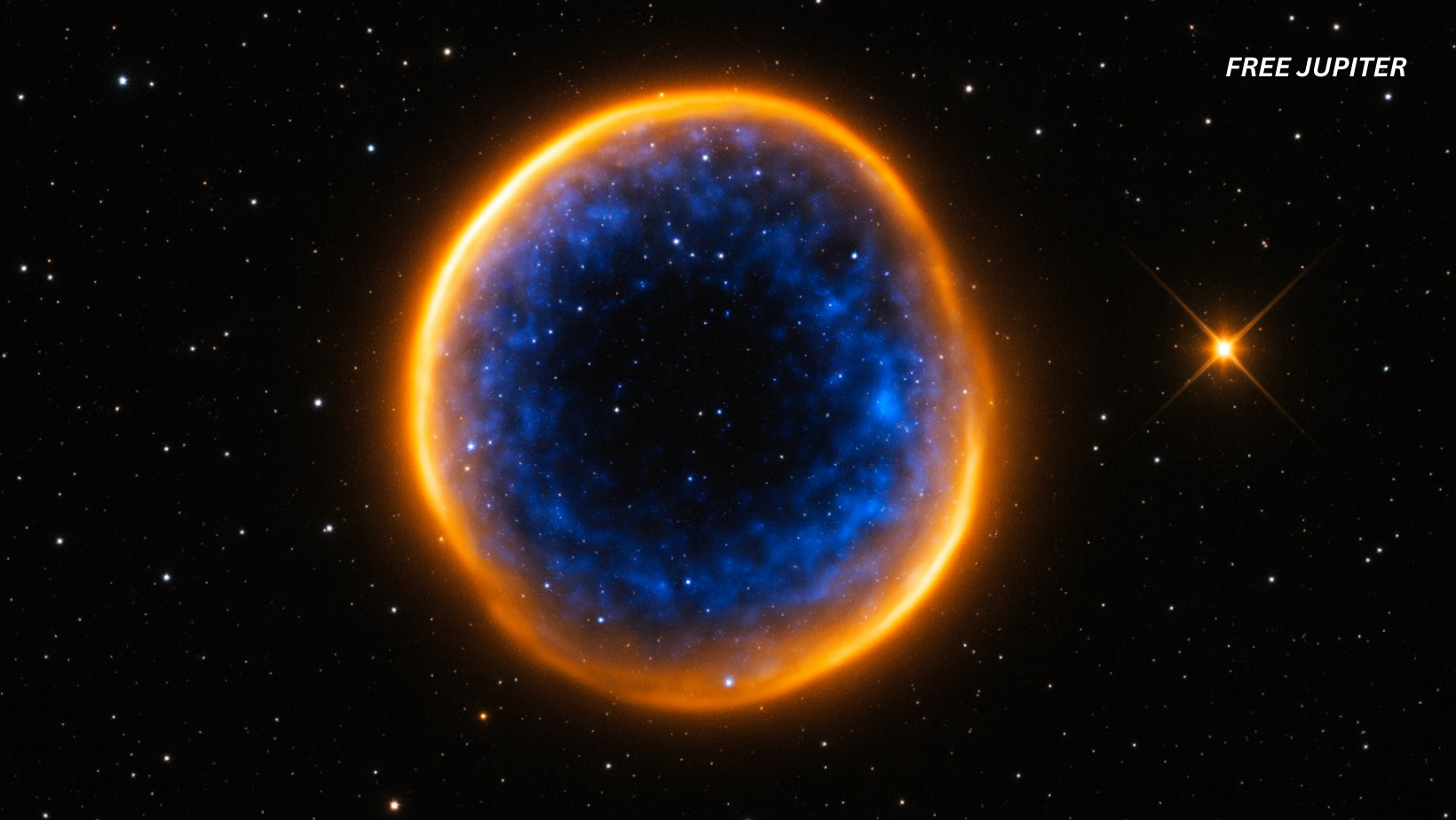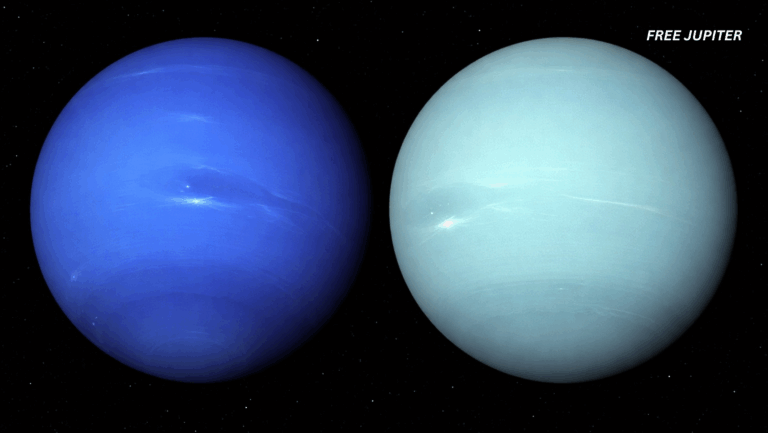Imagine stepping outside on a clear afternoon and, along with the Sun, seeing a brand-new “star” blazing brightly enough to rival the Moon. That scene may sound like something from science fiction, but astronomers believe it could actually happen in the not-too-distant future. A peculiar double star system called V Sagittae, about 10,000 light-years from Earth, appears to be heading toward an explosive finale.
This system has long puzzled researchers. It’s unusually bright for its type, it behaves unpredictably, and for more than a century scientists couldn’t quite figure out why. The latest studies, however, paint a vivid picture: one star is a dense stellar “corpse” known as a white dwarf, and it has been steadily siphoning gas from its larger companion. In effect, the white dwarf is a cosmic cannibal, drawing so much material that it’s primed for a thermonuclear event.
If current predictions hold true, the resulting outburst — likely a nova first, then a full supernova — could be bright enough to see with the naked eye even in daylight. That’s rare; the last comparable event clearly visible during daytime was the supernova of 1054, which produced the famous Crab Nebula and was recorded by astronomers in China nearly a thousand years ago.
What Exactly Is a White Dwarf?
To appreciate what’s happening in V Sagittae, it helps to understand what a white dwarf is. When stars roughly the size of our Sun exhaust their nuclear fuel, they shed their outer layers and leave behind a dense core about the size of Earth but with half the Sun’s mass. This “spent” star no longer fuses hydrogen into helium, so it gradually cools and dims over billions of years. Our own Sun is expected to end its life this way in about 5–6 billion years.
On their own, white dwarfs are fairly quiet. They’re like cosmic embers: hot, dense, but not explosive. Things change dramatically, however, if a white dwarf orbits close to another star. Its intense gravity can start pulling gas from its partner, a process astronomers call mass transfer. That stolen gas doesn’t fall straight onto the white dwarf’s surface; because of the stars’ orbital motion, it spirals inward and forms a disk of material — like water swirling down a drain — called an accretion disk. Over time, the disk dumps its contents onto the white dwarf, layering fresh fuel onto its surface.
Read more: Gravitational Wave Detector Has Confirmed Einstein and Hawking’s Black Hole Theories
How a Stellar Snack Turns Deadly
There’s a cosmic “speed limit” on how much matter a white dwarf can safely hold. This threshold, about 1.4 times the Sun’s mass, is known as the Chandrasekhar limit (named after Indian-American astrophysicist Subrahmanyan Chandrasekhar). Once a white dwarf crosses this boundary, gravity crushes the added fuel until it ignites runaway nuclear reactions. The result: a Type Ia supernova, one of the universe’s most reliable standard-candle explosions. Normally this event completely tears apart the white dwarf, leaving nothing but an expanding cloud of glowing debris.
In some cases, before the supernova happens, the white dwarf may undergo repeated smaller outbursts called novae. These are still dramatic but far less destructive — the star survives, though it brightens temporarily as accumulated gas ignites on its surface.
V Sagittae: The Oddball That Won’t Behave
V Sagittae isn’t just any white-dwarf system. First cataloged in 1902, it’s the brightest example of its class and has defied expectations for over a century. According to the new research team — which includes scientists from the University of Southampton in the U.K., the University of Turku in Finland, and Spain’s Instituto de Astrofísica de Canarias — the white dwarf here is devouring its companion at an exceptional rate.
Using the Very Large Telescope in Chile’s Atacama Desert (a cluster of four powerful optical telescopes perched over 2,600 meters above sea level), the astronomers mapped the system in unprecedented detail. They discovered something striking: both stars are enveloped in a giant halo of gas, essentially a cloud of material stripped from the companion star and sloshed around the system by the white dwarf’s intense activity.
This halo acts like a neon sign of instability. It tells scientists the white dwarf is swallowing more material than it can process — a bit like someone trying to drink from a firehose. The researchers also observed rapid changes in the system’s motion and brightness, further evidence that it’s nearing some kind of tipping point.
What the Experts Are Saying
Phil Charles of the University of Southampton described V Sagittae as “no ordinary star system” and emphasized that its extreme brightness stems from the white dwarf “sucking the life” out of its neighbor. Another team member, Pasi Hakala from the University of Turku, compared the surrounding gas ring to an overflow: since the white dwarf can’t handle all the incoming matter, the excess forms a glowing halo. This behavior, they argue, is a warning sign of an approaching violent event.
Astronomer Pablo Rodríguez-Gil added that the next stage may be a nova outburst — essentially a spectacular flare-up as built-up gas ignites — which would make V Sagittae visible to the naked eye. But the ultimate climax will come when the two stars finally merge or the white dwarf crosses its mass limit, triggering a supernova so bright it could rival the Moon’s glow even in daytime.
Read more: Dark Matter Could Spawn Black Holes That Consume Planets From the Inside
Why This Matters Beyond “Wow, a Bright Star”
Type Ia supernovae are crucial tools for astronomers. Because they explode at a fairly uniform brightness, scientists use them as “standard candles” to measure cosmic distances and study the expansion of the universe. In fact, observations of these explosions helped reveal the mysterious force we call dark energy, which is causing the universe to accelerate in its expansion.
Having a potential future Type Ia event essentially in our galactic neighborhood (10,000 light-years is far enough to be safe but close enough to be spectacular) would give scientists an unprecedented opportunity to watch one unfold in real time with modern instruments.
It’s also a vivid demonstration of how stars evolve. Our Sun is far too isolated to end this way, but many stars in binary or multiple systems live much more complicated lives, trading mass, spinning up, and sometimes colliding in cataclysmic displays. V Sagittae offers a front-row seat to these processes.
How Rare Is Daylight Visibility?
For context, even a typical supernova in our galaxy is rare — the last clearly visible one in the Milky Way occurred in 1604 and was studied by Johannes Kepler. Daylight visibility is rarer still. The “guest star” recorded in 1054 by Chinese and Japanese astronomers was so bright it cast shadows at night. Betelgeuse, the red supergiant in Orion, has been on astronomers’ watch lists because of its unpredictable dimming episodes, but its explosion is probably still tens of thousands of years away.
If V Sagittae indeed goes nova or supernova within our lifetimes, it would be the first event of its kind to be studied in detail with space telescopes, radio arrays, and gravitational-wave detectors, all of which didn’t exist during previous visible supernovae.
Read more: Astronomers Found The Largest ‘Ultramassive’ Black Hole Ever Seen
A Front-Row Seat to Stellar Evolution
No one can pin down an exact timeline for V Sagittae’s finale. Some models suggest a nova could occur within decades; the full supernova might follow within a century or more. Either way, the system’s frantic behavior indicates the clock is ticking. For now, astronomers continue to monitor it with the Very Large Telescope and other observatories worldwide.
For the public, the prospect is both awe-inspiring and humbling. Somewhere far away, two stars are locked in a deadly dance, one feeding on the other until the inevitable happens. If predictions hold, Earth’s sky will briefly host a second “sunlike” object — a cosmic reminder that even stars have life cycles, and that we’re fortunate to witness them from a safe distance.
Featured image: GPT-5o Recreation.
Friendly Note: FreeJupiter.com shares general information for curious minds. Please fact-check all claims and double-check health info with a qualified professional. 🌱










